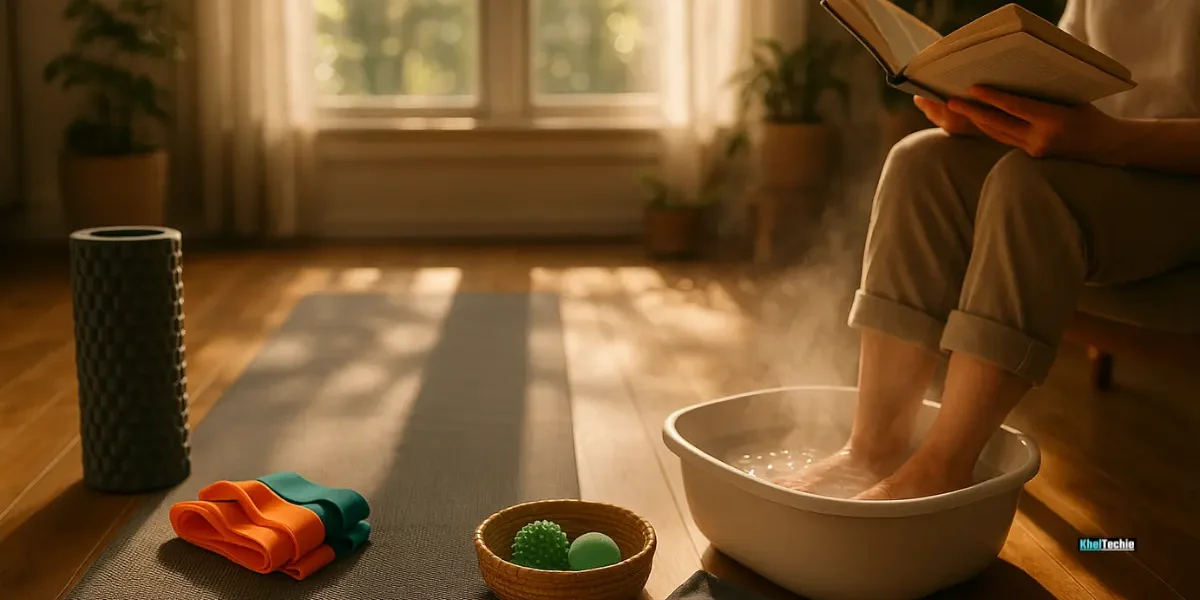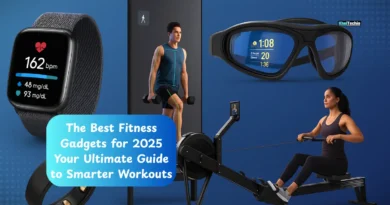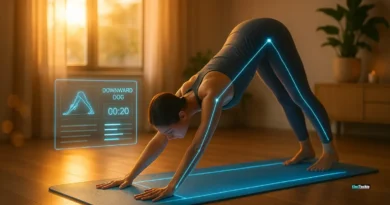Budget-Friendly Home Recovery Tools: Heal Smarter, Not Harder
Let’s cut to the chase!
You’ve just finished a tough workout, or maybe you’re dealing with chronic pain from sitting at your desk all day. Your body feels stiff, sore, and exhausted. You know you need some kind of recovery, but heading to a physical therapist every week? That’s not realistic.
Enter the budget-friendly home recovery tool, your personal rehab kit that fits your wallet and lifestyle.
This comprehensive guide will walk you through the best cost-effective recovery tools, how to use them, common pitfalls to avoid, and answer your burning questions. Let’s embark on this journey to affordable wellness together.
Also read – How to Create Personalized Workout Calendar (2025 Edition)
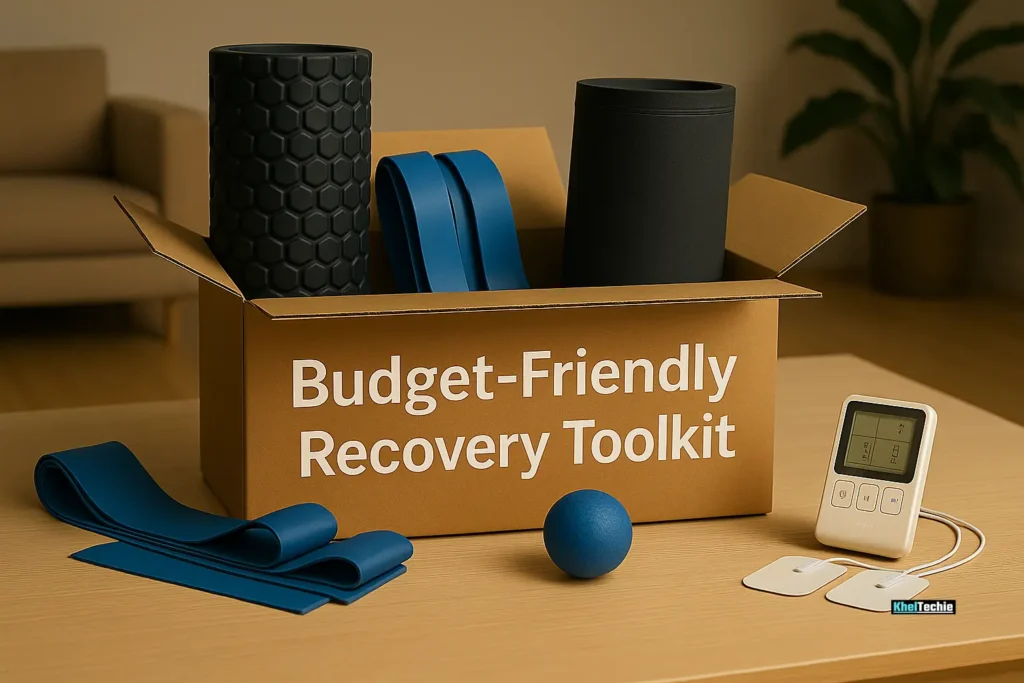
What Is a Budget-Friendly Home Recovery Tool?
These are affordable, easy-to-use devices or equipment designed to help you recover faster from muscle fatigue, minor injuries, or daily wear and tear, all from the comfort of your home.
Examples Include:
- Foam Rollers: Cylindrical tools used for self-myofascial release to relieve muscle tightness.
- Massage Balls: Small, portable balls that target specific muscle groups.
- Compression Sleeves: Garments that improve blood flow and reduce muscle fatigue.
- Epsom Salt Baths: Soaking in magnesium-rich salts to soothe muscles.
- Resistance Bands: Versatile tools for stretching and strengthening exercises.
They may not look fancy, but they do the job well and most cost less than a single session with a professional therapist.

Why a Budget-Friendly Home Recovery Tool Matters
Investing in recovery tools is no longer just an Option, it’s a must-have for your fitness and long-term health. According to the National Library of Medicine, foam rolling not only reduces muscle soreness but also improves flexibility and physical performance. The best part? You can do all of this at home without spending money on expensive massage therapy.
According to Athletech News, 2024 marked a major shift where recovery tools were no longer limited to athletes. People of all ages, especially working professionals and older adults have started adding foam rollers, massage balls, and compression sleeves to their daily routines. Why? Because they’re simple, effective, and budget-friendly.
In today’s world, where gym memberships and physiotherapy sessions are getting more expensive, these home recovery tools are becoming a smart and sustainable investment. Whether you’re a runner, someone with a desk job, or just trying to stay active and healthy, these tools work for everyone.
Bottom line? Budget-friendly home recovery tools give you control, comfort, and consistent results without draining your wallet. They’re not just a trend; they’re the future of affordable wellness.

How to Choose a Best Budget-Friendly Home Recovery Tool
Step 1: Identify Your Recovery Needs
Ask yourself:
- Do you have tight muscles after workouts?
- Do you sit for hours and suffer from lower back pain?
- Are you recovering from an injury?
Your answer will determine which type of tool works best for you.
| Need | Recommended Tool |
|---|---|
| Muscle tension | Foam roller, massage ball |
| Post-workout soreness | Massage gun |
| Joint pain or swelling | Compression wrap or ice pack |
| Stiffness or poor circulation | Resistance bands or heat pad |
| Chronic pain | TENS unit |
Step 2: Set a Realistic Budget
Here’s where many people go wrong, overspending on gadgets they don’t use. Start small, Focus on one or two essential tools that target your biggest issue.
For example:
- A basic foam roller = $20–$40
- Entry-level massage gun = $40–$80
- TENS unit = $30–$70
Step 3: Buy from Trusted Brands
Just because something is cheap doesn’t mean it’s safe or effective. Stick to brands with good reviews and certifications.
Some trusted names:
- Hyperice – Known for quality massage guns
- TheraBand – Leader in resistance bands
- TechCare – Affordable yet reliable TENS units
- RumbleRoller – High-performance foam rollers
Check Amazon, Walmart, or local sporting goods stores for deals. Look for products with at least 4-star ratings and recent customer feedback.
Step 4: Learn How to Use It Properly
Using a recovery tool incorrectly can cause more harm than good. For instance, applying too much pressure with a foam roller can bruise muscles instead of releasing them.
Considerations:
- Start slow and gentle
- Roll or press along the muscle, not directly over bones or joints
- Limit sessions to 2–3 minutes per area
- Stay hydrated and warm up before using any tool
Step 5: Create a Routine
Consistency is key. Make recovery part of your daily routine, especially if you’re active or spend a lot of time sitting.
Sample Daily Routine:
- Morning: 5-minute stretch + resistance band warm-up
- After workout: 10-minute foam roll + massage gun on major muscle groups
- Evening: Heat pad on sore areas or ice pack if swollen
5 Best Budget-Friendly Home Recovery Tools
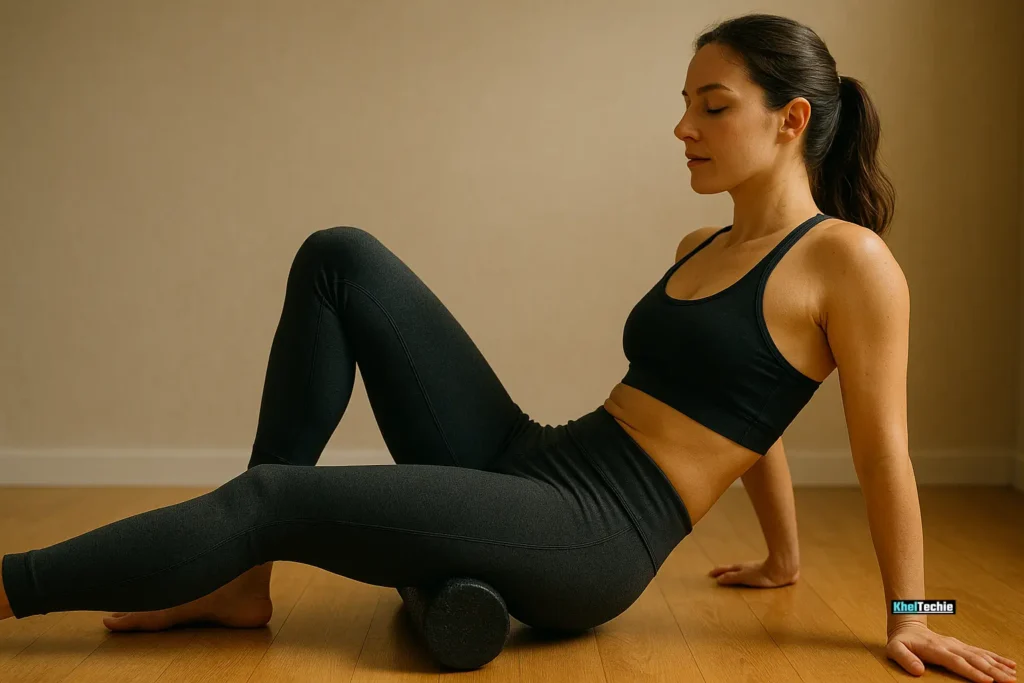
1. Foam Rolling
Purpose: Release muscle tightness and improve flexibility.
How-To:
- Place the foam roller under the targeted muscle group.
- Slowly roll back and forth for 30-60 seconds.
- Focus on tender spots, but avoid rolling directly over joints.
Use after workouts to aid in muscle recovery.

2. Massage Balls
Purpose: Target specific muscle knots and tension areas.
How-To:
- Place the ball between your body and a hard surface (wall or floor).
- Apply gentle pressure and roll over tight spots.
- Hold on tender areas for 20-30 seconds.
Great for feet, shoulders, and glutes.

3. Compression Sleeves
Purpose: Enhance blood flow and reduce muscle fatigue.
How-To:
- Wear sleeves during or after physical activity.
- Ensure a snug fit without restricting circulation.
Ideal for runners and individuals on their feet for extended periods.

4. Epsom Salt Baths
Purpose: Soothe sore muscles and promote relaxation.
How-To:
- Add 2 cups of Epsom salt to a warm bath.
- Soak for 15-20 minutes.
- Hydrate afterward to replenish fluids.
Incorporate calming music or aromatherapy for enhanced relaxation.

5. Resistance Bands
Purpose: Aid in stretching and strengthening exercises.
How-To:
- Use bands for dynamic stretches or resistance training.
- Incorporate into your warm-up or cool-down routines.
Choose bands with varying resistance levels to match your fitness level.

Common Mistakes to Avoid When Buying Budget-Friendly Recovery Tools
Even with the best intentions, people often make these mistakes:
❌ Skipping Research
Don’t buy the cheapest option just because it’s on sale. Read reviews, watch YouTube demos, and compare features.
❌ Overloading on Tools
Start with one or two tools that address your main issues. Too many gadgets clutter your space and drain your motivation.
❌ Ignoring Safety Guidelines
Some tools, like TENS units, have safety warnings. Always read the manual or consult a healthcare provider if unsure.
❌ Expecting Instant Results
Recovery is a process. Give your body time to adapt and heal. Most tools work best with consistent, daily use.
Also read – How to Restart Your Fitness Journey After a Setback

Final Thoughts: Invest in Your Body, Save Money Long-Term
Pain and stiffness don’t have to be a normal part of life, With the right budget-friendly home recovery tool, you can manage discomfort, boost performance, and take control of your health, all without draining your wallet.
Whether you’re a weekend warrior, a busy parent, or someone who sits at a desk all day, investing in a few smart tools can change how you feel every day.
So go ahead, start small, stay consistent, and give your body the love it deserves.
FAQs
What is the best budget-friendly home recovery tool for beginners?
A foam roller or resistance bands are excellent starting points. They’re affordable, versatile, and easy to use
Are TENS units worth it for home use?
Absolutely, especially if you deal with chronic pain. Just follow the instructions carefully and avoid using them on sensitive areas like the neck or chest.
Do budget tools really work as well as expensive ones?
In many cases, yes. Look for tools with solid build quality and user reviews. Some entry-level options perform nearly as well as premium models.
How do I clean and maintain my recovery tools?
Most tools can be wiped down with disinfectant wipes. Foam rollers and bands should be stored in a dry place. Check manufacturer guidelines for specific care.
Can I use multiple tools together?
Yes, combining tools like foam rolling and Epsom salt baths can enhance recovery.
Are there any risks associated with using these tools?
If used improperly, yes. Avoid pressing too hard, using on injured skin, or ignoring sharp pain during use.
Where can I find the best deals on home recovery tools?
Amazon, Target, Walmart, and eBay often have sales. Look for Black Friday, Prime Day, or end-of-season clearance events
How often should I use these recovery tools?
It’s recommended to use them 3-5 times a week, depending on your activity level and personal needs
Can these tools replace professional therapy?
They complement professional treatments but shouldn’t replace medical advice or therapy when needed
Can I travel with these tools?
Absolutely, Many are lightweight and portable, making them travel-friendly.
How do I choose the right foam roller?
Select based on your experience level. Softer rollers are ideal for beginners, while firmer ones provide deeper pressure.
Are there any DIY alternatives?
Yes, household items like tennis balls or rolling pins can serve as makeshift recovery tools

